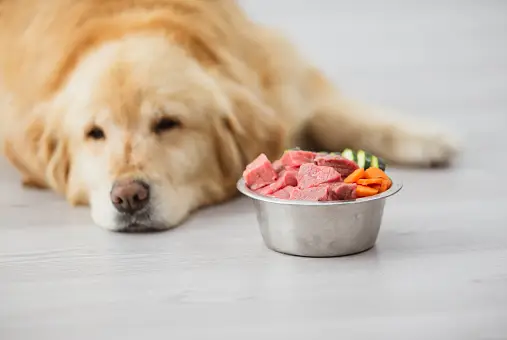Welcome to the tail-wagging world of canine care, where understanding the resilience of our furry friends is as important as the daily belly rubs. As a responsible dog owner, it’s crucial to grasp the gritty details of your pooch’s survival, particularly how long can a dog survive without food. Knowing this can be as essential as having their leash ready for that much-anticipated walk in the park. This article aims to fetch you expert advice on this topic, providing a guide that is much like a trusty map through the sometimes rough terrain of pet care. Together, let’s dig deeper into the knowledge kibble and ensure our four-legged companions receive the love and sustenance they deserve.

Understanding a Dog’s Nutritional Needs
Just as a well-balanced diet is crucial for humans, our canine companions also thrive on a nutritious meal plan. Dogs typically require a blend of protein, carbohydrates, fats, vitamins, and minerals to maintain their health and vitality. Regular meals not only fuel a dog’s daily adventures but also support their immune system, coat health, and muscle development. Skimping on their grub can lead to a doggy version of hangry, paired with the potential for serious health issues.
- Proteins: The building blocks for growth and repair.
- Fats: Essential for energy and absorbing vitamins.
- Carbohydrates: Provide fuel and help with digestion.
- Vitamins and Minerals: Crucial for preventing disease and ensuring good health.
Neglecting a dog’s dietary needs can have dire consequences such as weight loss, weakened immunity, and a lacklustre coat. Just like a car sputters without fuel, a dog without its kibble could quickly run out of steam.
Factors That Affect How Long a Dog Can Survive Without Food
Just as a melting pot of factors spices up our culinary cravings, a dog’s ability to go without food is not a one-size-fits-all scenario. A Chihuahua can’t be expected to wear the same size collar as a Great Dane, and similarly, their survival without nutritional food will differ. Age, breed, and size play critical roles in this survival saga. For instance, a young, energetic puppy might feel the pangs of an empty bowl more acutely than a wise, old dog who’s content to spend the day dreaming of chasing squirrels.
- Age: Younger dogs, still burning the candle at both ends, may have a harder time without their kibble compared to older, more sedentary pooches.
- Breed: Some breeds come with a metabolism that runs faster than a greyhound at the track, while others are more like a leisurely stroll in the park.
- Size: A pint-sized pooch can’t store as much reserves as a canine colossus, affecting their food-free endurance.
Moreover, a dog’s health is the stage on which this drama unfolds. A dog battling an illness or with underlying medical conditions might not be able to last as long without food. It’s important to watch for both physical and behavioural changes, as these can be the first signs that your furry friend is running on empty. So, while Fido can’t exactly tell us with words, he’ll certainly let us know when his stomach starts to rumble.
Stay Tuned: Idli as a food for dogs or Makhana
How Long Can a Dog Survive Without Food?
When it comes to our furry companions, the thought of them going without food tugs at our heartstrings. But life can be unpredictable, and pet parents must know just how resilient their pooches are in tough situations. Generally speaking, a healthy dog might survive without food for about five days to three weeks, depending on various factors like fat reserves and hydration levels. However, this is a mere estimate and not a rule.
- Age: Young pups and senior dogs may have less resilience compared to adults.
- Breed & Size: A petite Chihuahua will have different survival capabilities than a robust Great Dane.
- Health: Underlying medical conditions can severely reduce the time a dog can go without nourishment.
The clock is always ticking, and the longer a pooch goes without a meal, the higher the risk for serious health consequences. It’s not just about survival; it’s about maintaining a quality of life. So, while a dog may hold off the hunger games for a short while, it’s no substitute for a bowl full of kibble and a steady feeding schedule.
What to Do If Your Dog Goes Without Food For an Extended Period
When your four-legged friend skips the chow line for too long, it’s like a red flag waving in a stiff breeze—you know something’s up. If your dog hasn’t been eating for an extended period, it’s critical to approach the situation with a blend of care and consideration. Here’s your game plan:
- Stay Calm and Assess the Situation: Take a deep breath and evaluate how long it’s been since your dog last ate. Also, keep an eye out for signs of illness or distress.
- Gentle Reintroduction of Food: Think of your dog’s tummy like a sleepy bear waking from hibernation; it needs a gentle nudge, not a full-on parade. Start with small, frequent meals of easily digestible food.
- Keep Water Available: Hydration is the unsung hero in this tale. Ensure your dog has continuous access to fresh water.
- Monitor Your Dog’s Reaction: As they start nibbling again, watch for any signs of gastrointestinal upset or refusal to eat.
- Seek Veterinary Care: If your pup’s appetite doesn’t pick up the pace or if you notice any health concerns, it’s time to call in the cavalry—your trusted vet.
Remember, while you’re the head chef in your dog’s diner, you’re not the doc. If in doubt, always consult a professional. They have the expertise to guide you through the rough patches and back to tail-wagging times.
Conclusion
In the tail-wagging adventure of life with our four-legged friends, we’ve explored the meandering paths of a dog’s nutritional odyssey. From the rolling hills of everyday dietary needs to the unforeseen valleys where meals might be missed, every pup-parent should be geared up with knowledge. Understanding how long can a dog survive without food is more than just trivia; it’s a crucial piece of the puzzle in safeguarding their well-being.
Remember, every dog’s journey is unique, with various factors such as age, breed, size, and health shaping their resilience. If your furry pal skips a meal or two, don’t sound the alarm just yet, but always keep a watchful eye. Should your dog embark on an unexpected fast, it’s critical to reintroduce food cautiously and seek a vet’s guidance to ensure their safe return to feasting.
So, embrace your role as the guardian of the bowl, and let’s ensure every dog’s dish brims with love, care, and the sustenance they need to thrive.


